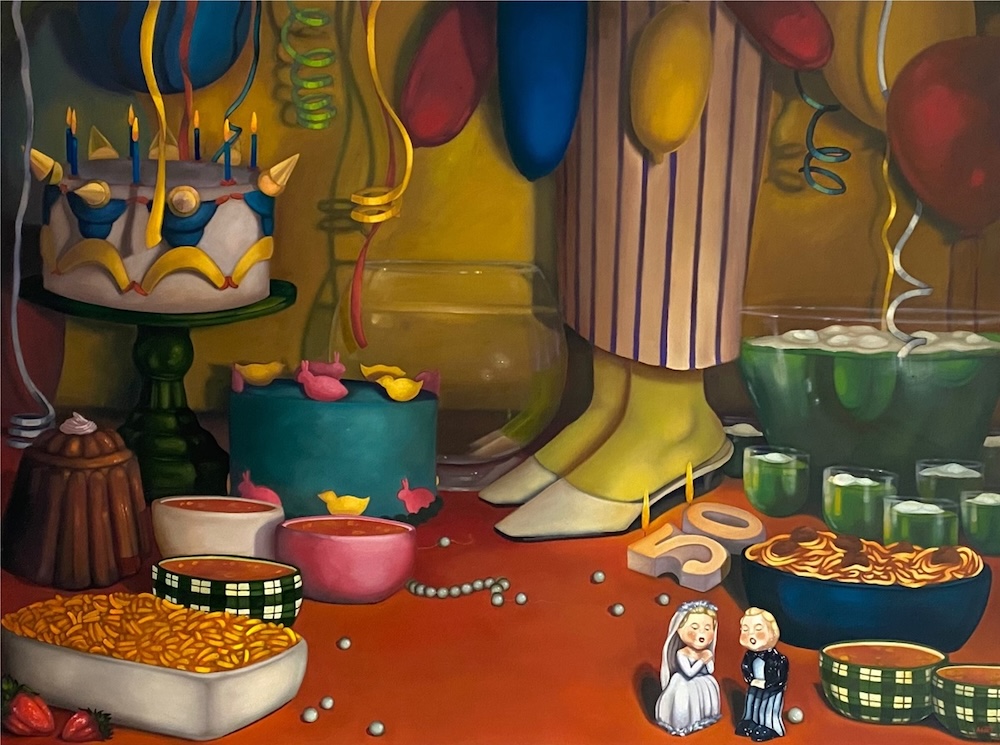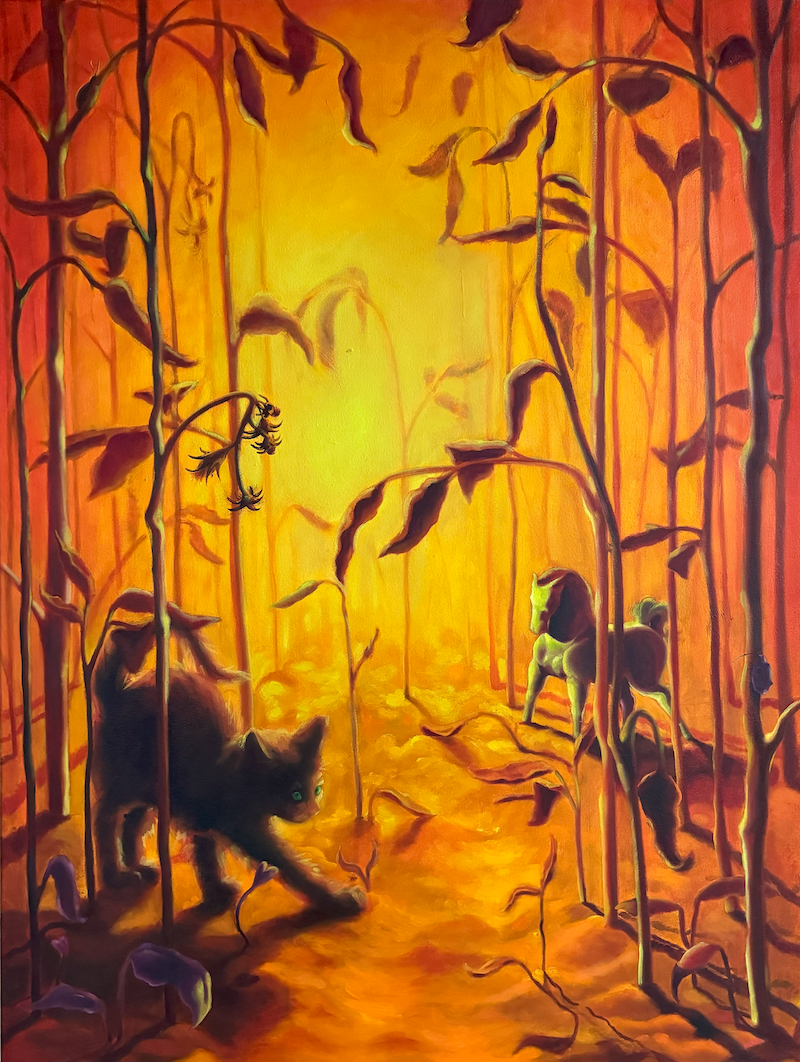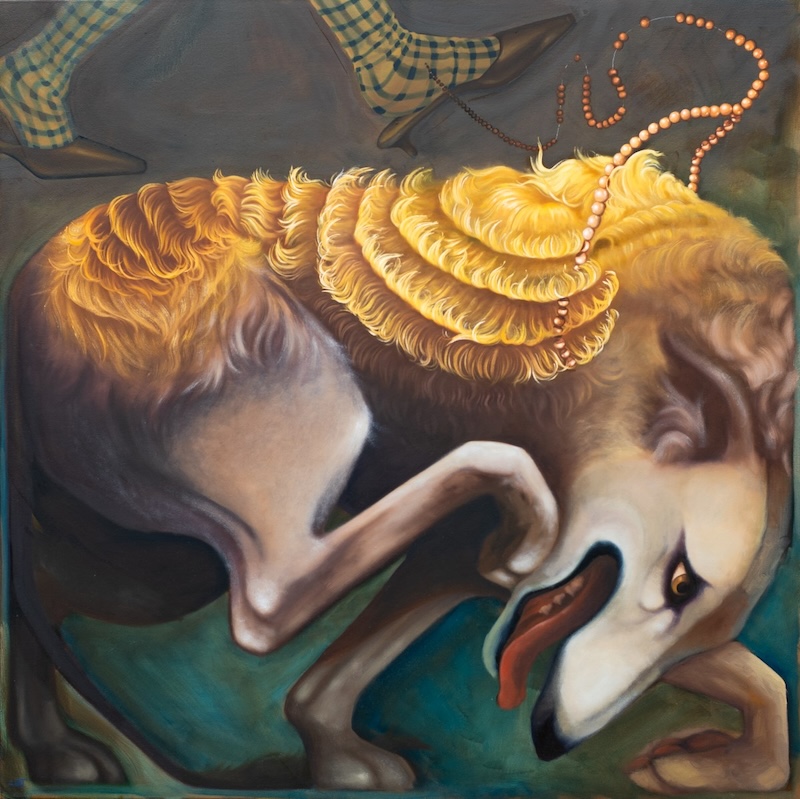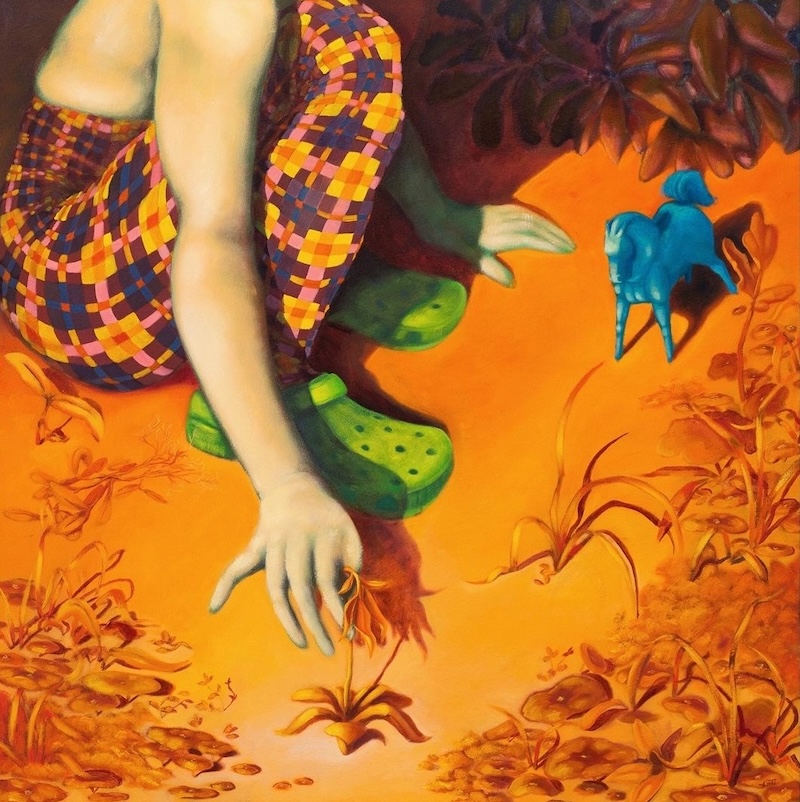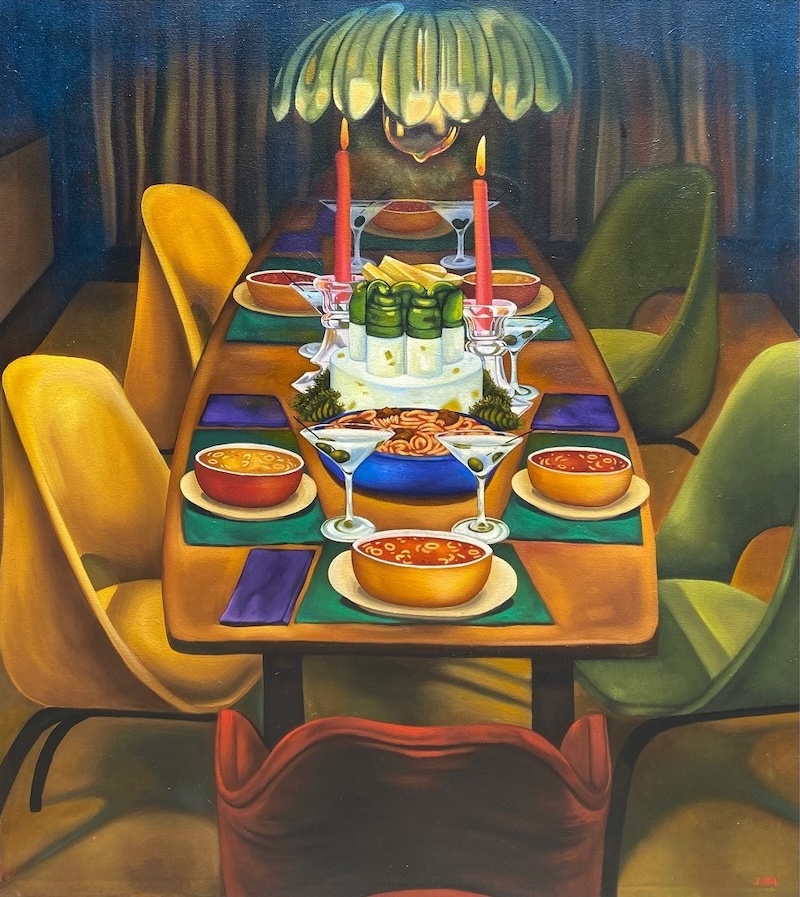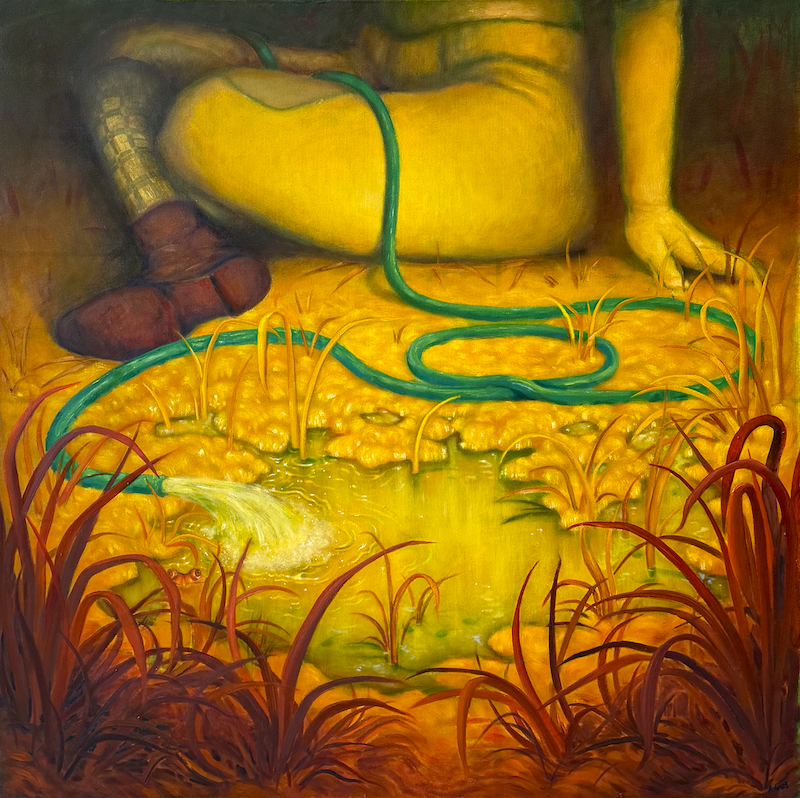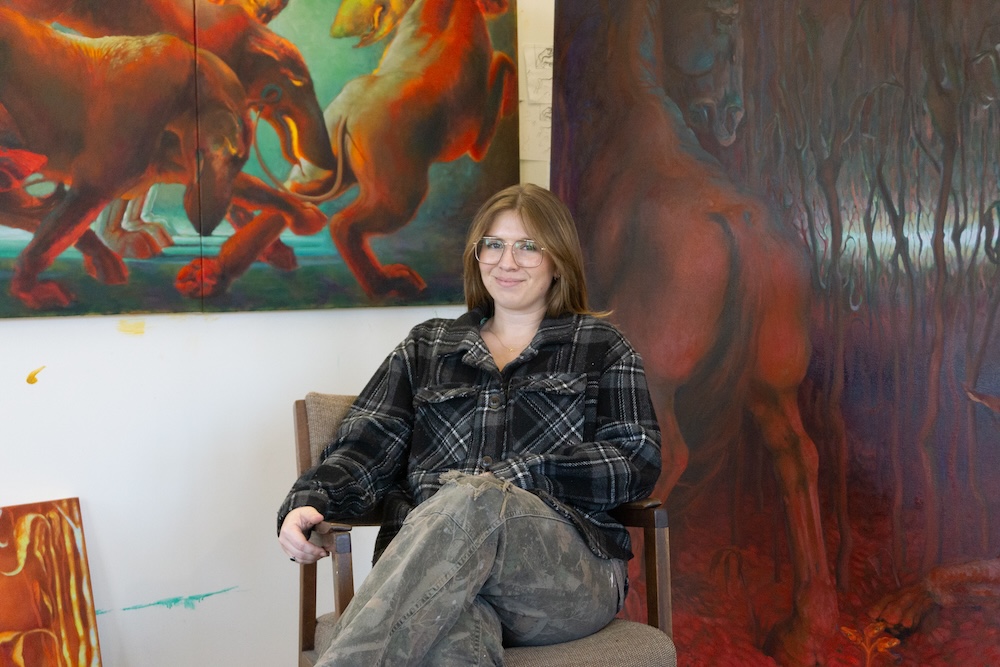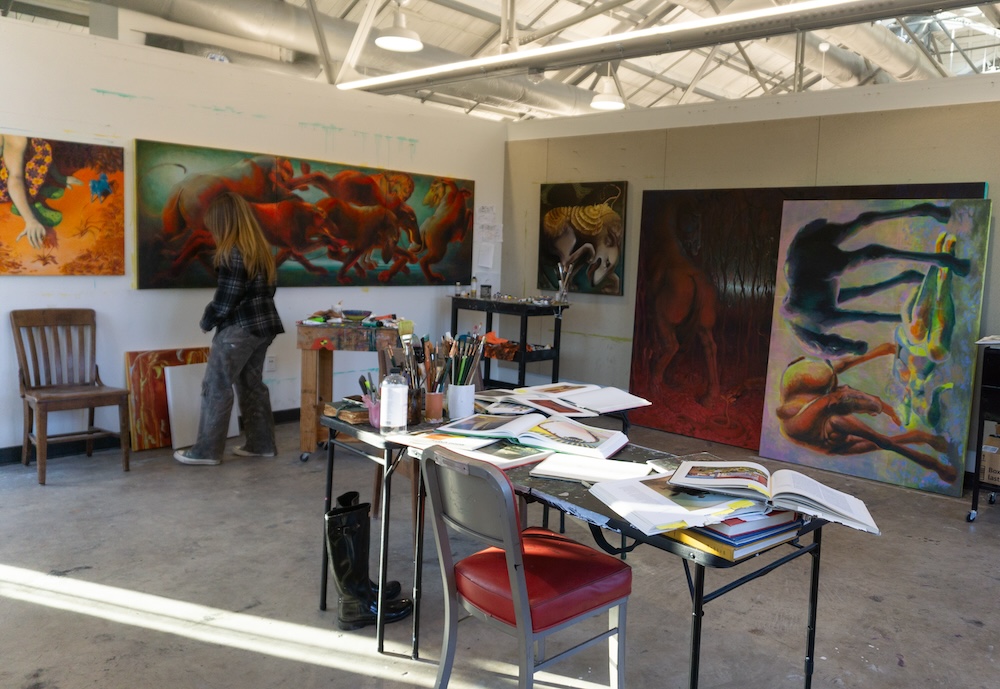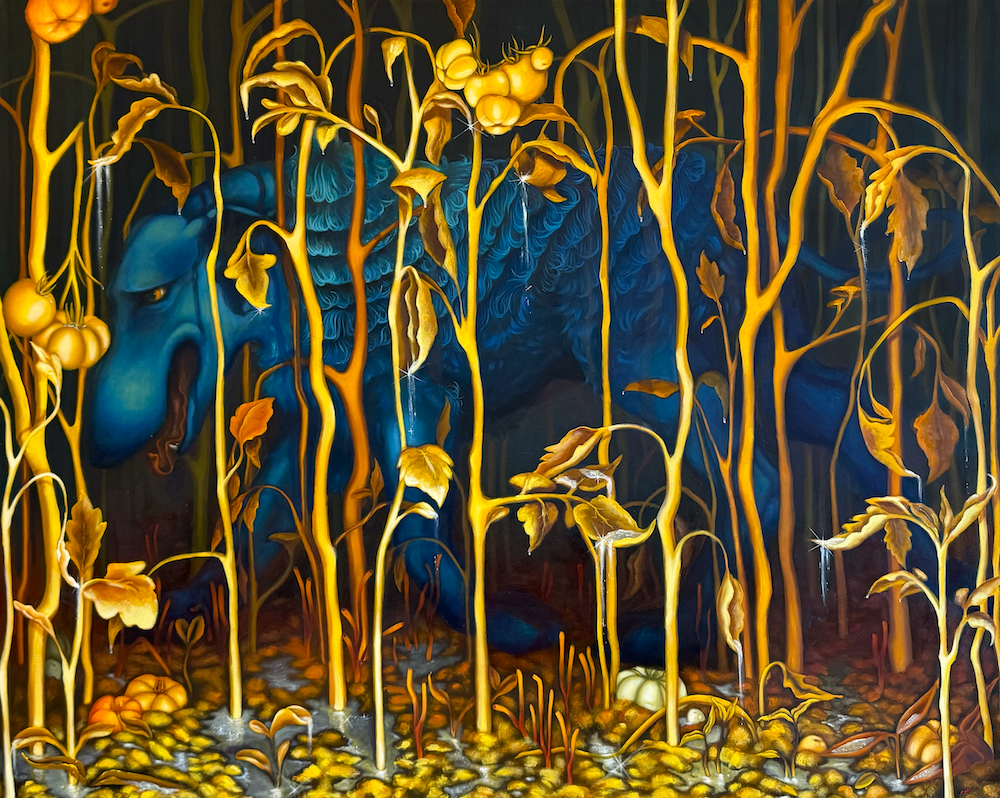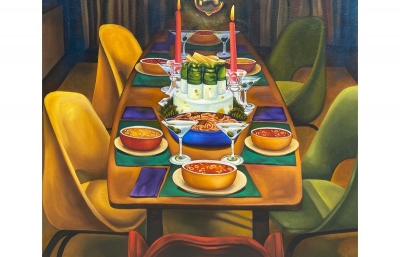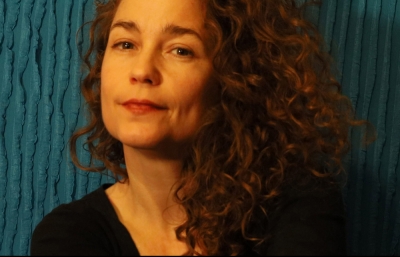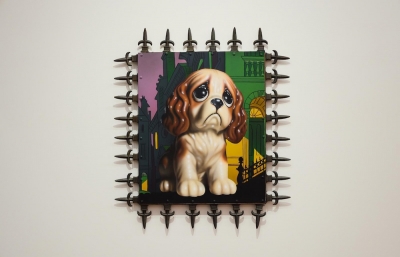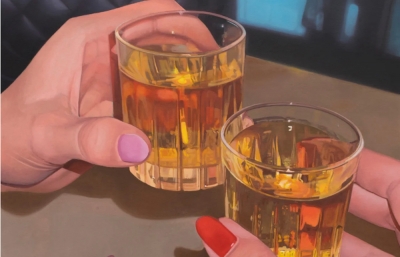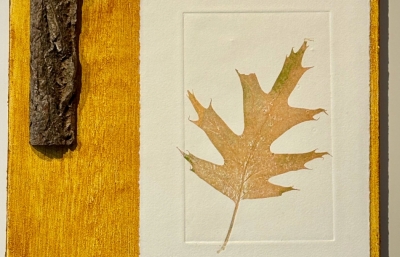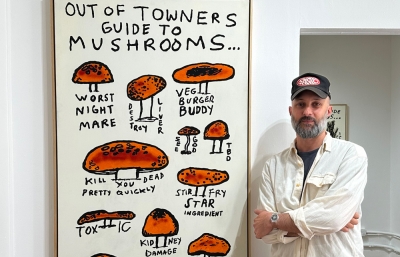It was Max Ernst who once said, "Art is the revelation of nature's darkest secrets, those that remain hidden beneath the everyday appearance." I went into the position as juror of the prestigious and utterly wild international exhibition Surreal Salon, held each year at Baton Rouge Gallery as celebrating the pop-surrealist/lowbrow movement, with this Ernst quote in mind. After, and within, such tumultuous times, there is something about the staid everyday appearance that begins to bend: it reveals malleability of the normal. So perhaps the most surreal scene I was to see was actually going to be a comment on the most familiar.
And that is what I saw in the winning work, Seating For Six, by Baton Rouge-based, LSU MFA student Amber Hart. The work depicts a mid-century modern dining room with a dinner table immaculately set for a party, with the peculiar element that there were no guests or intention of guests to sit down. All the while, the chef had prepared martinis and a Spaghetti-O-looking soup for the main course. It was striking in that it was, dare I say, kind of normal? Yet a stage scene for no one in particular and everyone all at once is also quite... surreal. It was jarring and rather haunting, a work that I saw as a comment on our overreaching desire to share our private lives to an audience that neither asked for or needed to see the intimacy of our home life. It also recalls the feeling of loneliness; the dinner party where no one arrives.
I visited Hart at LSU and then spoke with her a week later about the winning work of Surreal Salon 17 and the work she is preparing for her thesis show in the coming months.
Evan Pricco: So first off, it should be said. Congratulations on winning Surreal Salon 17. It was quite the experience being there this time and judging the competition first hand.
Amber Hart: Thank you! Yeah, I'm flabbergasted, and was especially when you called me up on stage.
The best part is that I didn’t even know, as I was supposed to know, that you're at LSU getting your MFA in painting at the moment. It made the trip to Baton Rouge extra special. I visited you at your studio, but how has the experience been there in general? What are you working on for your MFA show?
Since I'm in my last semester of my third year, I'm focusing on the thesis show, Ground Level. So I am on some of my last paintings for that. But the work is heavily determined by time. And that could be my moments from the past, specifically moments that I've watched from other individuals. I’ve said this in some of my artist statements: beware my wandering eyes because… I kind of consume the habits of others. And if the habits are consistent, they almost become memories themselves. So that's kind of where the work is coming from, the work that you saw, and then also what I'm working on now.
When did you know that you wanted to get an MFA in painting?
I was at the University of North Texas; a great school. I was supposed to be an interior designer, or that is what I thought I was going to be. Then I realized that my life would then be spending a lot of time on a computer and I decided that was not for me. I had some friends in the BFA program and we would be working alongside each other and I'd be working on making cabinets and they would be creating paintings or fine artwork. I was like, wait a second, I can go and study this!? And then during the pandemic, although very unfortunate for a lot of people, and it wasn't a great time per se, but I was able to sit down and for a year and a half decide that this is what I wanted. And I had developed a body of work that ended up being my first solo exhibition…
There's a really interesting thread here. So you were going to do interior design, which in a way is living through other people's ideas, or it can be about listening and processing other’s ideas and making something from another’s plan, so to speak. You were talking about how you're making paintings now about memory and other people's memories and how it becomes your own in a way. It’s like you have begun to make fine art with an interesting observational skill.
I guess I never reflected on that because I get so consumed in the now that I don't really look back too much at the interior design. But you're right, yeah, even the paintings in Surreal Salon, I'm combing through historical references in vintage American magazines of these interior spaces and then making them my own. So, yeah, they do align.
Let’s talk about the works that you had for Surreal Salon 17 at BRG, and specifically the one that won: the dinner table scene, called Seating For Six. Maybe just walk me through that particular painting.
I lived in Texas, the Dallas Fort Worth metroplex more specifically, for about 12 years. I realized that Dallas, for me, ended up being more of a subway station rather than a solid home. Just a lot of movement, all around me. So I think in this, I started to really think about the American Dream, began to idealize this living in one place, dinner parties with friends and family, perfect setting. I idolized and idealized the idea of home because it seemed to me within every three to four years, I was moving around or others were moving and nothing felt stable or set.
In Covington, Texas, where I had lived for 12 years before Dallas, it was tight knit. Everyone knows and knew everybody. There is a balance between Covington and Dallas in the work, sort of staying put and moving too fash. And I think that loneliness or longing I had in Dallas ended up coming into this painting with the idea of wanting to create a community for myself. Serving this meal.
What drew me to it was that loneliness, but also this knowledge that there could be people in the next room but pretty certain this was a table and meal for six that no one, not even the chef, was going to attend. Soup and martinis for no one. And in the aftermath of Covid and also this fake social media world where we live, where everybody's planning something, having friends over, so happy and full of the joys of friends and family and life, but those are all so staged moments. And your painting plays on life as a stage.
I don't think I ever looked at my work and been like, “I'm a surrealist.” I just followed what my interest was, which were these images of the American Dream that you would find in vintage interior design magazines and how I can incorporate myself into it. But then I guess maybe that is surrealism, the American Dream and what it does to us. But no, I never really categorized myself, but I think sooner or later, someone will categorize me. 
The paintings that I saw in your studio countered Seating For Six. There you had this manicured, controlled, curated indoor, domestic space, and then these other paintings are of the outside world. A bit more savage and raw.
The works in Surreal Salon speak to this idea and theme that I've never really lived in the present. Everyone would be talking about a tomorrow or a Friday night, and my brain was always five to 10 years ahead. The birthday painting, the second one in the Surreal Salon show (in gallery above), I believe the candles said "50." I made it when I was 25, already thinking, "What does my 50th birthday look like?" I'm already halfway there!
But these newer works, the thesis works, I've decided I can be more present with myself and my surroundings. I'm reconnecting with those childhood memories. The more foreboding paintings are, like how you said, savage, or almost like the emotional turmoil of dealing with the fact that I will be leaving this environment and what comes next.?
So what comes next?
I think everyone tells me to be patient, and I really struggle with that. But I want to be alongside the artists that I admire, I want my life to be around exhibitions and working within the art world.
Thank you Baton Rouge Gallery and all the work you do with Surreal Salon. Visit the LSU School of Art for more information on their program. Hart's MFA show, ?????? ????? opens April 26th, 2025.

